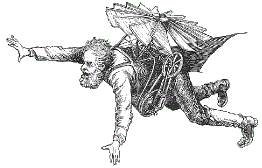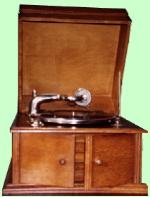| Gothic Steam Phantastic > Information > Sound of Steampunk |
 Sound of Steampunk |
 |
| -*- Home -*- Daleth-*- I&I RPG -*- Information -*- Forum -*- Credits -*- Links -*- |
|
So you want to have steampunk music on your speaker boxes, do you? Now please define, what is steampunk music to you? Does it involve the gothic, the fantastic? Looking at lovers of (epic) Fantasy, we see that they claim several genres to be “Fantasy Music”. There are four branches of Fantasy music: soundtracks of Fantasy movies, mediaeval music, traditional (Celtic) music and modern music based on either traditional or mediaeval music (or both). Period music seems very easy to get. Great composers lived in the Victorian Age. However, they might have been controversial at the time (The Beatles were not considers culture when they started, but now they are said to have changed pop culture of the sixties). And above all, they were culture for the upper class, and not the ones who made the music that was sung on the streets and in the pubs. On the other hand, you might be lucky because starting with the Romantic Era of the early nineteenth century, artist tried to make more “natural” art, and getting their inspiration from the lives of the common people. Art is no longer just about Kings, but also about a girl working in a tobacco-factory (“Carmen”). Another point is that music doesn’t stick to the period. Good music can be played for decades after another. Especially in a time when the entertainment industry was not as large as now, and there were no media to spread hypes as fast as light, a popular song might stay on the tongues of the singers for a very long time. This way, you can mix with music form earlier times. Keeping that in mind, you might actually buy period music the way it came back then. Original records and record players of the nineteenth century are still on sale - and when they are old enough, free of copyright for further use. The old records have to be played at 78 rpm. You can buy original record-players as the pathophone to play them, but if you want a better sound, are too lazy to turn the handle and/or are not afraid to use electricity, you can search for turning tables from the 1960s and 1970s that sometimes did have the possibility to play records at 78 rpm (with the regular 45 rpm for singles and 12-inches and 33 rpm for albums, you child of the silver disc era).
The sound of the old records depends a bit on how carefully they were handled by their owners. With normal use, they still sound clear. If you remember “Beau Belle” from the From Hell soundtrack, you have the wrong impression of ancient music: the actual sound is much better. Here is a small sample from the Cuckoo Waltz played on a pathophone (ca. 500 kB, mp3, opens in another window). Other “old music” can be found in the classic music department of your local record store, on CDs and LPs - and on sheet music. There is one problem with period music: it is no fiction. If the times changed, why would not the musical culture change with it? Fictional technological innovations could make it possible that not only the looks of the world changed, but also its music. What if the Fender Stratocaster was invented in 1850? Would there have been rock operas in the nineteenth century? If slavery is taken from the world, because steam powered robots do the dirty work, would there still be “black music” as Jazz and Blues (that come from slave culture)? By using sheet music to make your own music, you can alter parts of the music. Introduce different instruments, turn up the beat, make it faster, use tricks that have been introduced in music with rock and dance music. You can also try to mix the CDs with your own beats from music-maker software. However, many DJ found that classic music doesn’t always keep straight to the beat and mixing might be difficult then. Someone who remixed some classic music was Malcolm McLaren & the Bootzilla Orchestra who did this for the Waltz Darling album. If we take a look at soundtracks, they appear to be period music as well, but they are in fact not. Soundtrack music comes in two parts: the music used as a song in the movie (especially during the opening titles and end credits), and music to set a certain mood. Setting a mood involved playing with the strings of the emotions of modern mankind, not playing the strings of a violin the way they played it in Habsburgian Vienna. If we compare the soundtrack of From Hell (set in 1888) and the modern hacker-movie “Sneakers” (set in the 1990s), there is not much difference in the music. Both soundtracks have the same composer (Trevor Jones), but that is not what makes them similar. It’s just that it’s hard to have a calm movie with action music. The other way around, a punk-action movie like “Return of the living death” could live very well with an upbeat punk soundtrack, and the sound of surf suited well to “Pulp Fiction”. Considering this, for steampunk action you might be looking for something very different from Victorian chamber music. You might find some examples on soundtracks, but you can also look a bit further into the music scene. For special occasions, during game play for example, you can use specialised music. March music for your war game, some national hymn during a royal meeting. There are a lot of CDs on sale that give you the right sound effects. Sound effects are the sounds of birds, trains, but also include “atmospheric music” to set a mood. Including traditional music, national hymns and march music. As for the national hymns, some of them are based on the same composition so it’s not that bad to play a hymn from the wrong country. If you stick to historical correctness, keep in mind that national hymns changed during the centuries. Traditional music is there to capture the soul of a nation or a culture. However, most traditional music doesn’t date further back than the nineteenth century. Popular examples of traditional music or music with traditional elements are music by Bedrich Smetana (Ma Vlast) and Edvard Grieg (Peer Gynt Suite) - even if you’re not into classical music you might recognise their music. Of course, traditional or national music should set the mood for a specific setting. It contains at least elements of a tradition that we associate with a certain country. For your average Gothic Horror campaign set in Transylvania, you might want to use music by Bartók or Kodaly (both Hungarian composers). Still, traditional music, like period music, is probably not what you are looking for in a fictive setting with extended drama and a sense of suspense, of mystery and horror. Maybe you can turn to modern music instead. There is no music labelled “Steampunk” in the stores, so you have to find something else. There are modern bands who have recorded their interpretation of nineteenth century novels or early movies. Notably are the Tales of Mystery and Imagination album by the Alan Parsons Project for the music of Edgar Allan Poe, and the soundtrack for Das Kabinett des Dr. Caligari by In the Nursery. Another source for inspiration might be the Goth music, where In the Nursery also comes from. But be careful, Goth music comes in many different flavours and not all might fit. There is Goth music reviving mediaeval music in a neo-gothic/Victorian style, there are Goths playing rock music, and some playing Industrial, among other styles. If you like Goth music, this might be what you’re looking for, but the mix of Victorian music and Industrial sounds is difficult to find. And there is yet another way, which might be very interesting: playing modern music on old instruments. This does not have to be elevator music, but with a bit of rock spirit you might do what a skilled Dutch piano player and comedian, Vincent Bijlo, once did: on the festival for old music he sat down at an antique harpsichord and played a song by the Rolling Stones, claiming the Stones were “ancient music” too... (source of information: Trouw newspaper) Now that is what I call steampunk! The Vienna Symphonic Orchestra did about the same when recording Falco’s “Rock me Amadeus”. What Apocalyptica does -as we can hear on the Vidocq soundtrack- is writing modern music for old instruments (cello) and that doesn’t give the same effect... but maybe just what you are looking for. In the end, as said before, music is there to set a mood. If you don’t like a certain kind of music, you will feel disgruntled when hearing it instead of having fantasies of steampunk. With that in mind, you might have your luddites sing the Sex Pistols “Anarchy for the UK” and let the gentlemen dance to Nirvana’s “Smells like teen spirit” (as shown in Moulin Rouge!). Simple new age music playing in the background and using death metal for the action scenes... if you like. © Yaghish 2004 The music sample of The Cuckoo's Waltz is taken from a vintage record by an unknown orchestra and equally unknown composer on the Parlephon label. I assume it was released in the 1920s, but I'm not sure and can't find any information on it. |
| Links |
|
| -*-© Steammasters 2003-*- |
| ^ Up |
